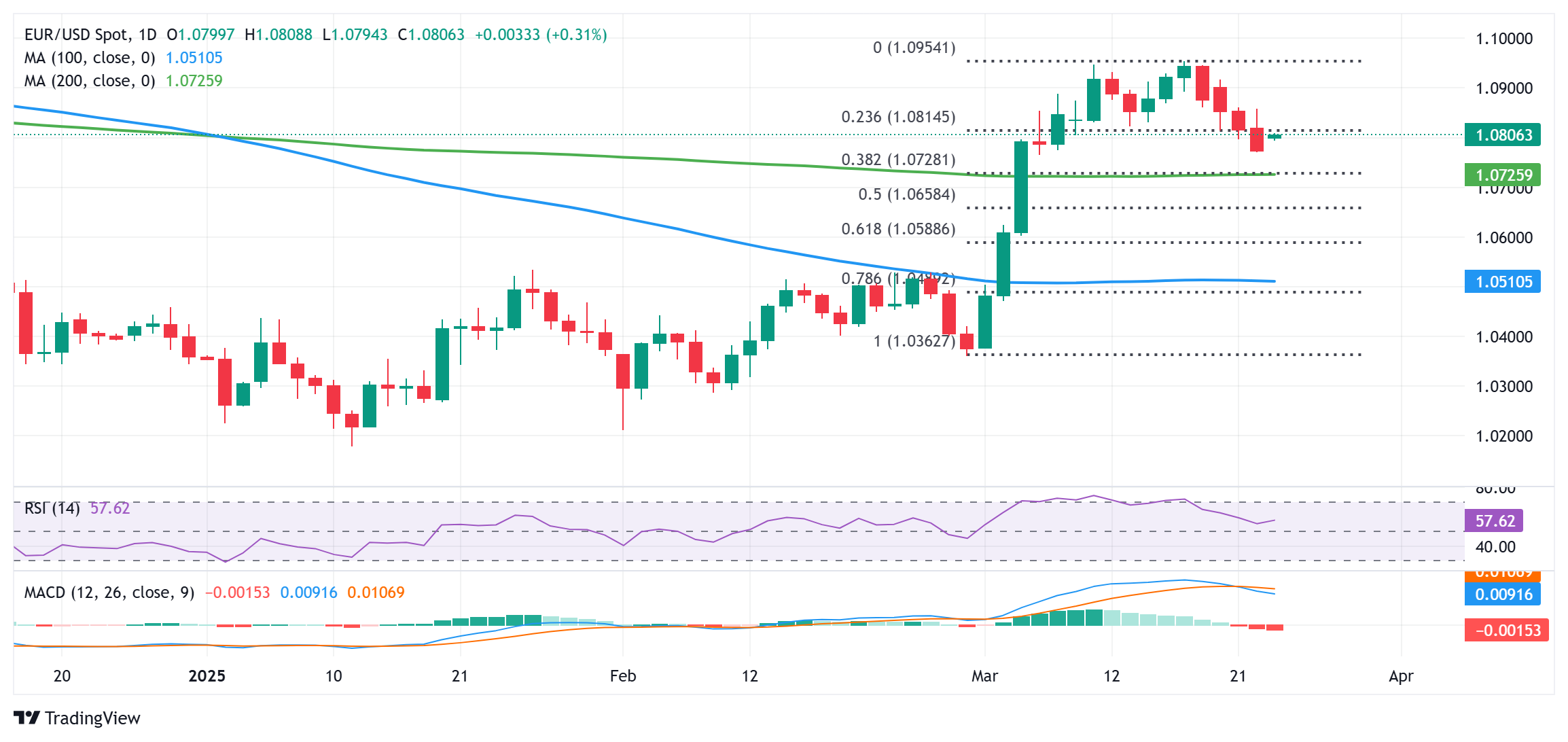EUR/USD rebounded slightly from two-week lows hit the previous day.
The technical situation appears to be tilted towards the bearish side, supporting the prospect of a deeper decline.
A sustained break above overnight highs is needed to remove the negative bias.
The EUR/USD pair attracted some buying during Tuesday’s Asian session and now appears to have snapped a four-day losing streak, rebounding to around 1.0770 area hit the previous day. The spot price recaptured the 1.0800 mark amid weak US dollar (USD) price action, although this advance lacks bullish conviction.
From a technical perspective, the overnight break and close above the 23.6% Fibonacci retracement level of the recent rally from the late February lows is seen as a key trigger for bearish traders. This, in turn, supports the prospect of an extension of the correction from the year-to-date highs hit earlier this week and further declines to the confluence of 1.0725. The latter includes the 38.2% Fibonacci level and the very important 200-day simple moving average (SMA), which should act as strong support for the EUR/USD pair on the daily chart.
However, a sustained break below would indicate that the spot price has topped out around the 1.0955 area and pave the way for a deeper decline. The subsequent decline could drag the EUR/USD pair below the 1.0700 round-figure mark towards the next relevant support level, close to the 1.0655 area (50% Fibonacci), and further down towards the 1.0600 level, or the 61.8% Fibonacci level. A possible follow-through sell-off could shift the bias in favor of bearish traders and expose the 100-day SMA, around the 1.0500 psychological mark, while also approaching the 78.6% Fibonacci level.
On the other hand, the overnight high around the 1.0855 area now appears to be an immediate obstacle, and a breakout could trigger a wave of short-term covering, allowing the EUR/USD pair to recapture the 1.0900 round number. Momentum could extend further, retesting multi-month highs around the 1.0955 area before spot prices eventually climb to the 1.1000 psychological mark for the first time since early October 2024.

The Euro is the currency of the 19 European Union countries that belong to the Eurozone. It is the second most traded currency in the world after the U.S. dollar. In 2022, the Euro accounted for 31% of total foreign exchange transactions, with an average daily turnover of more than $2.2 trillion. EUR/USD is the most traded currency pair in the world, accounting for about 30% of all transactions, followed by EUR/JPY (4%), EUR/GBP (3%) and EUR/AUD (2%).
The European Central Bank, based in Frankfurt, Germany, is the reserve bank for the eurozone. The ECB sets interest rates and manages monetary policy. The ECB's main task is to maintain price stability, which means either controlling inflation or stimulating growth. Its main tool is to raise or lower interest rates. Relatively high interest rates - or expectations of higher interest rates - are generally good for the euro, and vice versa. The ECB's Governing Council meets eight times a year to make monetary policy decisions. Decisions are made by the presidents of the eurozone's national banks and the six permanent members, including ECB President Christine Lagarde.
"Eurozone inflation data, measured by the Harmonized Index of Consumer Prices (HICP), is an important econometric indicator for the euro. If inflation is higher than expected, especially above the ECB's 2% target, the ECB will have to raise interest rates to control inflation. Relatively high interest rates compared to other countries are generally good for the euro because it makes the region more attractive as a place for global investors to put their money. ”
Data released can measure the health of the economy and can have an impact on the euro. Indicators such as GDP, manufacturing and service PMIs, employment and consumer confidence surveys can all affect the direction of the euro. A strong economy is good for the euro. Not only will this attract more foreign investment, it may also encourage the European Central Bank to raise interest rates, which will directly strengthen the euro. Otherwise, if economic data is weak, the euro may fall. Economic data from the four largest economies in the eurozone (Germany, France, Italy and Spain) is particularly important because they account for 75% of the eurozone economy."
"Another important statistic for the euro is the trade balance. This indicator measures the difference between a country's export revenue and import expenditure over a given period. If a country produces popular exports, then its currency will gain value purely from the additional demand created by foreign buyers seeking to purchase these goods. Therefore, a positive net trade balance will strengthen the currency and vice versa."